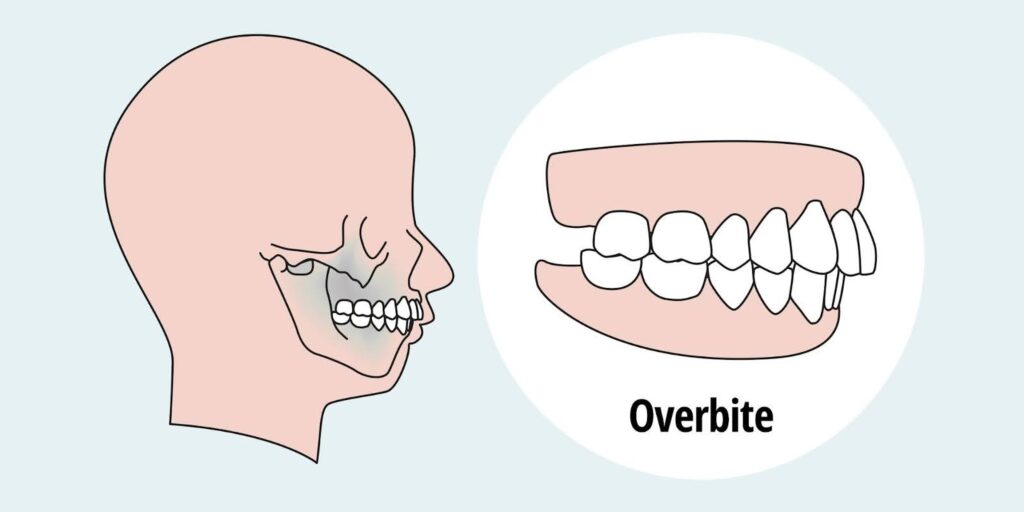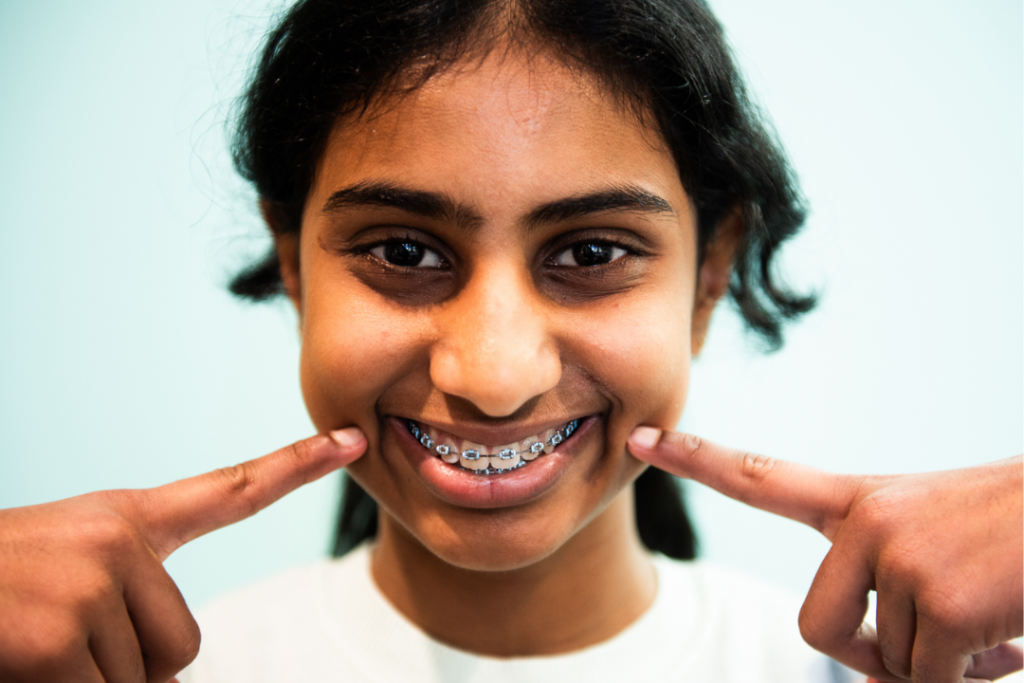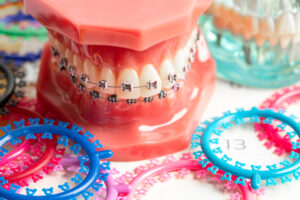Overbites are very common, and most people have them.
However, if your top teeth overlap your bottom teeth by a significant margin, then you may have a larger overbite than is normal.
An especially large overbite can cause an issue that orthodontists refer to as a ‘deep bite.’ This can lead to discomfort, uneven wear on your teeth, and impact your smile.
The good news is that there are lots of ways to fix an overbite.
If you’re wondering :
- How long does an overbite take to fix?
- How much does it cost to fix an overbite?
- How long does it take braces to fix an overbite?
- Or how to fix overbite as an adult?
Ortho Co. can help. As a trusted Sydney orthodontist, we specialise in creating beautiful, lasting smiles for our patients.
From lingual braces to Spark aligners, if you’re wondering how to fix an overbite, we can come up with a tailored treatment plan that works for you.
What is an overbite?

The normal range for an overbite is 2-3mm. If your overbite is smaller, your lower teeth will be more visible.
In cases where the overbite is significantly reduced or absent, it is known as an anterior open bite, where a gap remains between the upper and lower teeth when the jaws are closed.
Some people don’t like the look of an anterior open bite, and want it corrected for this reason alone.
On the other end of the spectrum, a larger overbite results in less visibility of the lower teeth. In severe cases, this can cause excessive wear on the lower teeth or even damage the gums behind the upper central incisors.
If you suspect you have an overbite, scheduling a consultation with an orthodontist is the first step.
Causes of an overbite
When it comes to overbites, there’s usually no one at fault. Overbites are mostly caused by genetic factors outside our control such as having a smaller lower jaw or severely crooked teeth.
As you get older, you may find that your overbite becomes more pronounced as our teeth tend to become for crooked as we get older.
Types of overbite
Dental overbites :
Dental overbites occur when your teeth don’t line up quite right.
Your upper and lower jaws might actually be in good balance, but because your teeth are misaligned, your lower jaw ends up getting pushed back toward your neck.
The good news is that, in adults, this overbite can usually be fixed without surgery.
Skeletal overbites :
A skeletal overbite happens when your lower jaw is too small to match up with your upper jaw. Because of this size difference, your upper teeth end up sticking out over the lower ones.
Unlike dental overbites, skeletal overbites usually need surgery to properly realign the jaw.
Choosing the right treatment
In most cases, patients want to correct their overbites for aesthetic reasons, but overbites can also cause long term dental and health problems, including making speech and chewing more difficult.
In severe cases, your lower front teeth can hit the gum line behind your upper front teeth, which can lead to gum damage over time.
In some cases severe overbites can cause you to lose your teeth due to the heavy forces from biting down with a very deep bite.
An overbite can also mean premature tooth wear, jaw clenching, jaw tightness and pain, headaches, and the risk of developing Temporomandibular Joint Disorder (TMD).
Your orthodontist will be able to give specialised advice and provide a custom treatment plan, but in general you have two options—you can fix your overbite with braces, or with surgery.
How to fix an overbite with braces

Braces are one of the most common ways to fix an overbite. They work by gradually shifting your teeth into better alignment, which helps correct the bite over time.
Most orthodontists use rubber bands along with braces to pull the upper and lower teeth into the right position. It’s not an overnight fix—it usually takes a couple of years—but the results are worth it.
How long do braces take to fix an overbite?
On average, it takes 2 years to fully correct an overbite with braces.
The exact time depends on how severe the overbite is, how well your teeth respond to treatment, and whether you follow your orthodontist’s instructions
How long do elastics take to fix an overbite?
If you wear your elastics as directed (which means all the time, except when eating or brushing), they can start making noticeable changes within a few months.
However, for full correction, they usually need to be worn for 6 to 12 months—sometimes longer if the overbite is severe.
How to fix an overbite without braces?
If, for whatever reason, you don’t want to go down the path of traditional braces, then you have another option.
Clear aligners, like Invisalign, can work for mild to moderate cases, using custom trays that gently move your teeth over time.
If an open bite is caused by habits like tongue thrusting or thumb-sucking, myofunctional therapy (which helps retrain your tongue and mouth muscles) might help.
Some adults with very minor overbites or open bites even get cosmetic dental work like veneers or bonding to improve the appearance without actually moving the teeth.
In children with deep overbites, a plate can sometimes fix their deep overbite whilst the baby teeth are changing to adult teeth.
Surgery to correct an overbite
For severe overbites—especially skeletal ones—braces alone might not be enough. In these cases, jaw surgery is often recommended.
This means repositioning the jawbones to create a better bite. It might sound scary, but it’s done under anaesthesia.
Recovery takes a few weeks to a few months, and in the end, you’ll have a properly aligned bite, improved facial symmetry, and long-term relief from jaw pain or discomfort.
How to fix an overbite yourself
You can’t fully fix an overbite on your own, but there are things you can do to prevent it from getting worse.
If you have a habit of resting your tongue against your teeth, try myofunctional exercises to train your tongue to stay in the right position.
If you clench or grind your teeth, wearing a night guard can help prevent extra stress on your bite.
And if you suspect a developing overbite, see an orthodontist sooner rather than later to save yourself bigger problems down the road.
Cost considerations
| Treatment Option | Estimated Cost (AUD) | Factors Affecting Cost |
| Braces | $7,000 – $8,800 | Type of braces (metal, ceramic, lingual), treatment length, private health insurance |
| Clear Aligners (e.g., Invisalign) | $4,000 – $9,000 | Complexity of case, number of aligners, provider fees, insurance coverage |
| Jaw Surgery | $10,000 – $25,000+ (after Medicare & insurance) | Surgeon’s fees, hospital stay, anaesthesia, private health insurance |
| Myofunctional Therapy | $100 – $250 per session | Number of sessions, therapist experience, insurance coverage |
| Cosmetic Fixes (Veneers, Bonding) | $800 – $2,500 per tooth | Number of teeth treated, material used, provider fees |
| Night Guard (for teeth grinding) | $300 – $700 | Custom vs. over-the-counter, dental office vs. online |
Ready to take the first step?
There are plenty of ways to fix an overbite—whether that’s with braces, aligners, surgery, or smaller tweaks like myofunctional therapy.
The best approach depends on how severe your overbite is and what works for your lifestyle and budget.
If you’re unsure about your bite, the first step is to come see us at OrthoCo. We can walk you through your options and help you figure out the right treatment plan.
As experienced Burwood orthodontists, we understand that fixing an overbite isn’t just about looks—it can also improve your speech, jaw pain, chewing, and overall dental health.
If you’ve been putting off getting your overbite checked out, now is the perfect time to take that first step.
Call and book an appointment today.







